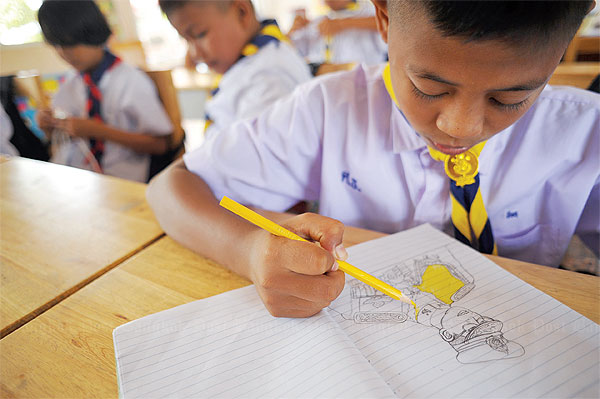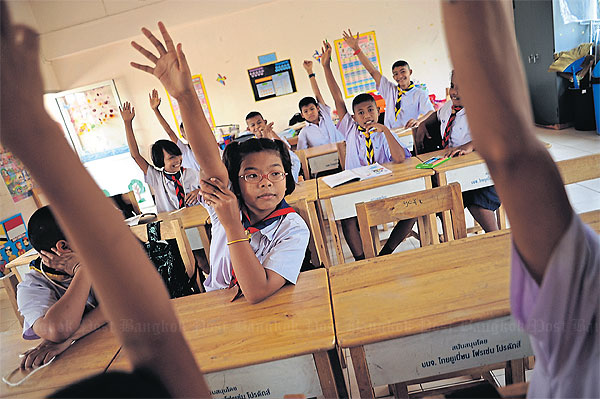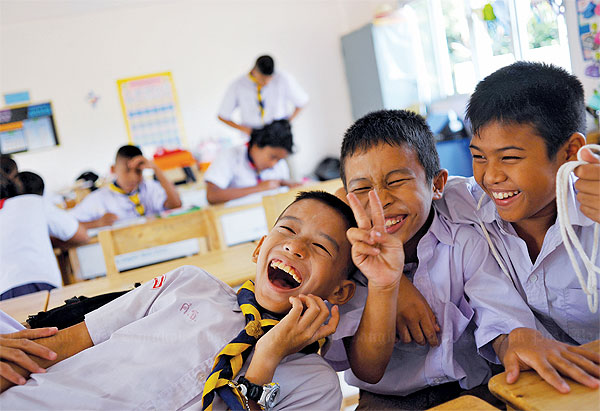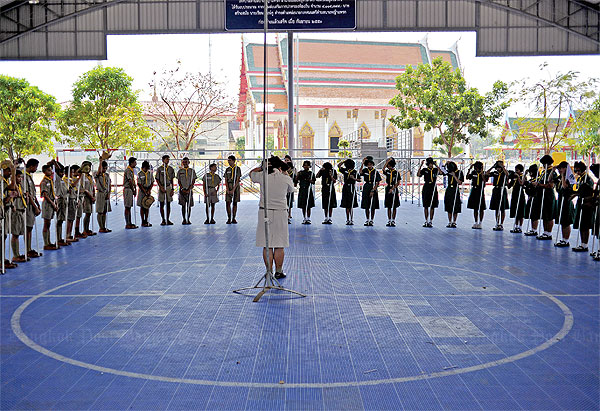Bright yellow shipping containers are stacked three storeys high on the rocky ground next to a Don Muang construction site on the outskirts of Bangkok. It could be the graveyard of a disused port, but from one container on the ground the sound of children’s voices can be heard.

“Gor gai”, “khor khai”, “kor kwai”, “ngor ngu”, the students chant in unison, the first four characters of the Thai alphabet.
The metal container has for over a year served as a makeshift school for the children of some 1,000 migrant workers from Cambodia, Myanmar and Laos employed to build a condominium development on an adjoining site.
Their homes are the gaudily painted containers which stretch in uniform rows like a Lego city. Once the condo project is completed in March, their container homes will be lifted onto trucks and shifted to the next job, along with their families and children.
But one of the containers has been converted to a learning centre to try and help the workers’ children overcome the problem of language and literacy.
Classes are voluntary, and the day Spectrum showed up 22 children were in attendance.

Self-contained: Top, shipping containers are used as housing at a Don Muang work site. One of the containers acts as a classroom, above.
ANATOMY OF HOPE
There is only one teacher, Pairote Jantarawong, and the lesson moves on from the alphabet to learning names for parts of the body in Thai.
He says “rang gai”, or “body” in Thai. Some of the students are almost familiar with this word — body is pronounced “riang gai” in Cambodian, very similar but not quite right.
The teacher corrects them and they slowly change the way they pronounce it. “Raang gaai” they eventually shout in unison.
The makeshift classroom is not a nursery or kindergarten, and it does not follow the national curriculum. But the learning centre is a new concept in a country that relies on an estimated 1.6 million migrant workers in sectors including construction, real estate, fishing and the services sector.
At the construction site, the men work and the wives and babies tag along. At a daily wage of 300 baht before being charged for things like “document services”, and with transient work that requires moving at least once a year, the children of migrants often receive little to no education, whether it be formal or otherwise.
Even if they want to be educated in a Thai public school, arduous background and document checks as well as language barriers usually force migrant parents, particularly if they are unregistered, to drop the idea altogether.
According to the Foundation for Rural Youth, there were about 300,000 migrant children — Myanmar, Lao and Cambodian nationals — in Thailand. In 2013, only about 30% were enrolled in schools or informal learning centres.
Growing up in worker camps, where very few Thai nationals live and work, it is nearly impossible for children to gain even basic Thai literacy without access to education. For many of those children, exploitation is a serious threat.
But a few NGOs are working to turn the situation around, if only a little, and even beneath a hot metal roof under the blazing midday sun.

Active education: A volunteer assistant at the Don Muang migrant worker camp leads children in an physical education class, one of several informal classes held while their parents are at work.
TEACHING FROM THE HEART
Pairote Jantarawong has spent the past year sleeping in the container that functions as a classroom during the day. This makes him a well-known figure at the Don Muang construction site among engineers, contractors, workers and the children who are never hesitant to knock on his door after sunset for a lesson or a snack.
Mr Pairote estimates that 80% of the construction workers at the site are from Cambodia, while the rest are from Myanmar, Laos and Thailand.
From January to December last year, 340 migrants came to the learning centre, where their personal information and photos were recorded to make it easier for them once they move on to a new work site.
The number of children who go to the centre fluctuates, depending on which phase of construction a particular project is at. During times where specialised skills are required, the workers occupying the camps will be paid higher, which means more family members are likely to tag along.
Mr Pairote, 51, has worked with the Foundation for the Better Life of Children for the past 30 years. He’s been through dozens of construction sites across the country which employed migrant workers, looking after children and making sure they possess Thai language skills.

Life lessons: Above, Thongpoon Buasri. Below left, Pairote Jantarawong.
“Migrant children look after themselves during the day as their parents go out working,” he said. “If the children are very young, they are locked up in their parents’ room. But the bigger children must be able to at least come out and get something to eat, and they need basic Thai for that.”
Mr Pairote now has two volunteer assistants to help him organise activities with the 22 children under his care. The lessons range from basic Thai and mathematics to meditation, games, storytelling and drawing. But mostly it is up to the children to do what they want to do, as their parents drop them off around 6am and don’t return to collect them until 6pm.
Mr Pairote cooks lunch for the students, and snacks and milk are available all day. Field trips are organised every once in a while, such as a recent visit to Dusit Zoo.
“Migrant parents do not want the children to go around calling for unwanted attention or embarrassment, as their documents are mostly kept by the contractors and also because of the language barrier,” Mr Pairote said.
“Once they’re outside the construction compound alone, they are in harm’s way, and can be lured easily by any stranger.”

‘Getting better’: Sompong Srakaew, director of the Labour Rights Promotion Network.
OUT OF DANGER
Thongpoon “Kru Jiw” Buasri, Mr Pairote’s colleague, has also worked for several decades to secure the rights of migrant children to education. She agreed that migrant children’s safety improves substantially once a learning centre is located on construction sites.
“The learning centres can help reduce sexual harassment among youths on construction sites, particularly during day time when the parents are out,” she said. “It also means the younger ones are not running around near heavy machinery, and means they can at least have something to eat during the day.”
Ms Thongpoon said part of the challenge was convincing large real estate development companies to see the benefits of the learning centre project. Now, many are willing to get on board and support the project.
The learning centres were initiated by Foundation for the Better Life of Children secretary-general Wallop Tangkananurak in 1986. “Since then, the programme has covered 34 construction sites and worked with seven real estate corporations who allowed us to operate with our own staff and budget, while they provided the makeshift metallic shelter,” Ms Thongpoon said.
“The financial crisis in 1997 forced the project to come to a stop. But in 2007, real estate corporation Narai Property approached the foundation, saying it wanted us to organise a learning centre on its sites, which we did until the flood crisis of 2011.
“Then in December 2013, TTS Engineering, who operates this very construction site, said it had a container for us. So we jumped in and with the help of the Wijit Pongpan Fund, which provides a 500,000 baht annual budget, we are able to cover the teacher’s pay, meals and learning materials while the construction company handles utilities and other costs.”
In March, the workers will pack up the Don Muang camp and move to a new construction site on Sukhumvit. “But this container will also go with them, along with myself and Mr Pairote.”

Drawing inspiration: A Wat Srisutharam School student colours a picture of His Majesty the King.
‘SHE WILL HAVE OPTIONS’
At times, Ms Thongpoon’s attempt to educate migrant worker’s children seems fragile, faced with opposition from education authorities who continually ask for the children’s permanent residence, education background and parents’ occupation. But in recent years, she has been able to put three migrant children into the formal education system. Even though they are over-aged for the classes, she hopes to see the fruit of education eventually.
“Four years ago, I put a 13-year-old Myanmar girl named Jin in a Prathom 3 class. Usually Prathom 3 children are eight years old, but she moved around with her parents a lot for menial jobs,” Ms Thongpoon said.
“After discussing with the school’s principal and speaking with Jin’s parents, she got accepted.”
Jin is now 17 and is studying her first year of high school. “I want her to finish at least Mathayom 3 [Grade 9], which is only another two years of study. From then on, doors will open for her. She could continue with an informal or vocational education to get higher qualifications, or she could work in a convenience store or factory. She will have options.”

True colours: Children at Wat Srisutharam School can hone their creative talents.
FORMAL EDUCATION
Girls like Jin are not alone — in areas with high migrant populations, efforts are being made to help children enter the formal education system.
In Samut Sakhon, Wat Srisutharam School is one of four schools in the province to mix Thai and migrant students, mostly from Myanmar, in the same classroom.
According to the founder and director of the Labour Rights Promotion Network, Sompong Srakaew, Samut Sakhon houses the second-highest number of migrants in the country, after Bangkok.
According to official estimates, the province is home to about 250,000 documented migrants of working age and 6,000 children aged under 15. In reality, the actual number is likely to be double those figures.
“I think there is probably around 10,000-12,000 migrant children in the province,” Mr Sompong said.
The LPN estimates that only around 2,000 migrant children in the coastal province have received any form of education, whether it be from the formal education system or learning centres in their ethnic communities.
“What will happen to the other two-thirds of them?” Mr Sompong asked.

Be prepared: Above, migrant students receive language training at the Wat Srisutharam School Care Centre. Below, students at the school take part in Scouts training.
LANGUAGE BARRIERS
Wat Srisutharam School categorises its migrant students into two groups. The first are those children at the kindergarten level, who can more easily blend in to classes with their Thai peers. For these kids, language is less of a barrier as both they and their Thai classmates begin formal lessons around the same age.
The second group comprises older migrant children, who have either arrived in Thailand recently or who have been here for several years without receiving any education.
The school provides two “Care Centre” classes — beginner and intermediate level — to this second group to prepare the students before they can qualify to enrol in normal classes.
On the day of Spectrum’s visit, there were 16 students attending the intermediate Care Centre class. The young students could all speak Thai, although their ability to read and write varied. Asked how many of them are Myanmar, six raised their hands. The rest said they were Mon.
Dressed in school uniform with the school’s initials on the right breast and his name on the left, one 11-year-old student said he has been in Thailand for four years after moving here with his parents. “My dad peels off the outer shell of prawns,” he said.
Pukong is another of the Mon students, whose father works on a fishing trawler. The 12 year old was born in Thailand but his language skills are still not good enough to attend the normal school system.
After spending a year at the Care Centre, Pukong was allowed to move up to normal elementary classes last year. "But I was demoted back to the Care Centre this year because the Thai language is difficult,” he said.
Asked if he feels embarrassed to be repeating the class, he shrugged and smiled while pointing to the others.
“These four students were moved down to this class as well,” he said.

‘THE SITUATION IS BETTER NOW’
According to the LPN, Samut Sakhon is likely home to between 300,000 and 400,000 migrant workers, who mostly serve the province’s vast fishing and food-processing industries. A large portion of them, around 150,000, are from Myanmar, followed by Laos and Cambodia.
After international labour protection agencies accused businesses in the province in 2010 of employing child labour, the public and private sectors have made efforts to boost access to education for migrant children. The Care Centre in Wat Srisutharam School was built by Thai Union Frozen Products PCL.
“The situation is much better now, but I cannot say whether the number of child labourers is down to zero,” Mr Sompong said.
The cabinet announced in 2005 that all migrant children, regardless of whether their parents are legally documented, are entitled to receive education in Thailand. In reality, those without legal documentation are unlikely to enrol their children in government schools.
“Migrant workers contribute significantly to Thailand’s economy. Education is not only beneficial to migrant children and their families, but also to Thailand as a host country and the Asean community as a whole,” said Chitra Thumborisuth, national director of World Vision Foundation of Thailand.
Mr Sompong said Thailand should ensure that all migrant children received proper education.
“Otherwise, we will be blamed by others for not protecting child rights, as was the case when the US accused the Thai fishing industry of employing child workers in 2010,” he said. “We should put these children in school rather than leaving them to vulnerable situations such as human trafficking or drugs.”

OVERCOMING INTOLERANCE
Piyawan Pongpipat, a teacher at Wat Srisutharam, said today around 300 of the school’s 600-700 students are migrants.
The transition has not all been smooth. “I was not here when they started accepting migrant kids eight years ago, but I heard that there was some resistance from parents and teachers,” Ms Piyawan said.
“After years of mixed schooling, people in the community have grown to become more accepting and realised the benefits of having migrant children in school. These kids become more responsible and disciplined instead of turning to bad things, which would be bad for the community here.” Due to the limited resources from their parents, some students cannot attend school regularly.
“Some are too young to take a bus to school on their own. Some miss class regularly. But overall, they understand the benefit of education,” Ms Piyawan said.
“During the teacher-parent meetings, I met parents who cannot speak Thai and they are happy that their child can speak Thai and English.”
Asked if the migrant children faced any discrimination issues at school, Ms Piyawan said, “Children are innocent, especially when they grow up in this cross-cultural environment. Some Thai students are even motivated to learn Burmese as their third language [after Thai and English].”
The challenge is finding the resources to support the migrant students.
“They don’t have to pay tuition fees but they are responsible for their own educational supplies such as books and uniforms,” Ms Piyawan said. But with many of their parents earning minimum wage or lower, finding the money to purchase these supplies is not always easy.
Mr Sompong said the LPN helped find donors to support extra teachers for migrant students and Burmese language classes in these schools.
CROSS-CULTURAL PLAYGROUND
In the school playground, it is difficult to distinguish Thais from the migrant students. They all look alike and speak in fluent Thai with no trace of a foreign accent. More often than not, though, the age gap between classmates is significant. Among a crowd of 20 Prathom 6 students, there were two migrant students aged 18.
One of those older students, Chan, said his parents are originally from Mon state in Myanmar. “I was born in Kanchanaburi and moved here later,” he said.
Chan has been studying at Wat Srisutharam for four years. He began in Prathom 1, or Year 1, at the age of 14 but managed to skip Prathom 2 and Prathom 4 on his way to the Sixth Grade. “The teachers may think that I am too old for primary school,” he said.
Chan does not know if his parents will ever go back to Myanmar. But when asked what he wanted to be in the future, the boy said firmly, “I want to an engineer,” before running to join the rest of students in another class.
OBSTACLES REMAIN
Ms Thongpoon said the education system remains reluctant to fully welcome migrant children, mainly because individual teachers and schools do not want to receive poor annual evaluations from the Ministry of Education.
Migrant children, due to their language barrier, could be a factor that tarnishes the school’s performance due to the blanket nature of the annual evaluations.
However, Ms Thongpoon said funding should not be a problem for schools, as according to the 2007 Education Act, free education is offered in Thailand to all children until the age of 15, or Mathayom 3.
“The education system provides for teachers’ pay, textbooks, stationery, uniforms and other extra activities at a cost of around 2,800 baht per student,” she said.
“Recently, I was able to put 10 migrant children, whose parents are beggars in the area of Samut Prakan province, into kindergarten."
The LPN paid 28,000 baht for them initially, but for the next semester, the school will shoulder the cost with funds from the Education Ministry.
“Now that the birth rate in Thailand has reduced considerably, the national budget should more easily be able to ensure equal access to education.”
PUSHING FOR CHANGE
Back at the Don Muang construction site, Ms Thongpoon is now pushing for authorities to implement mandatory requirements that work sites operating for more than six months and with more than 100 workers provide a learning centre for workers’ children.
Ms Thongpoon said education authorities need to be more aggressive in providing education or equipping migrant people with Thai literacy skills.
“This sort of learning centre that the foundation is running can also function easily under the Office of Informal Education, the Labour Ministry or the Ministry of Social Development and Human Security. They could work together to make it happen,” she said.
“They should adhere to the non-discrimination basis of child welfare, and that includes education. Many Thais fear migrants will become Thai or will replace Thais as they share our resources in schools, but education is their basic right.
“I want migrant children to at least say that Thailand treats them well while they are here. That alone makes me happy.” n